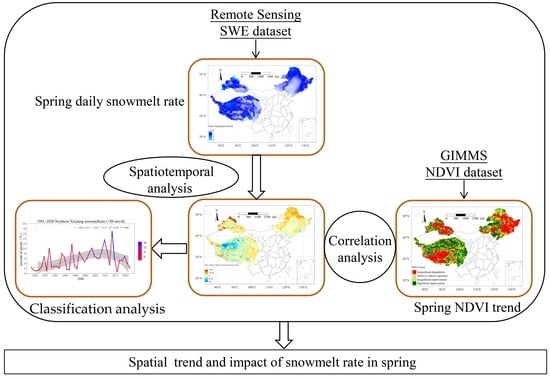Spatial Trend and Impact of Snowmelt Rate in Spring across China’s Three Main Stable Snow Cover Regions over the Past 40 Years Based on Remote Sensing
Abstract
:1. Introduction
2. Materials and Methods
3. Results
3.1. Spatiotemporal Dynamics and Tendencies of Annual Maximum SWE
3.2. Spatiotemporal Dynamics and Trends of Snowmelt Rate in Spring
3.3. Shifts in Snowmelt Onset Day across the Three Stable Snow Cover Regions
4. Discussion
4.1. The Relationship between Snow Depth and Snowmelt Rate
4.2. Possible Ecological and Other Environmental Impacts from a Changing SWE and Snowmelt Rate
5. Conclusions
Author Contributions
Funding
Data Availability Statement
Acknowledgments
Conflicts of Interest
References
- Barnett, T.P.; Adam, J.C.; Lettenmaier, D.P. Potential impacts of a warming climate on water availability in snow-dominated regions. Nature 2005, 438, 303–306. [Google Scholar] [CrossRef] [PubMed]
- Ke, C.Q.; Li, X.C.; Xie, H.; Ma, D.H.; Liu, X.; Kou, C. Variability in snow cover phenology in China from 1952 to 2010. Hydrol. Earth Syst. Sci. 2016, 20, 755–770. [Google Scholar] [CrossRef]
- Wu, X.; Zhang, W.; Li, H.; Long, Y.; Pan, X.; Shen, Y. Analysis of seasonal snowmelt contribution using a distributed energy balance model for a river basin in the Altai Mountains of northwestern China. Hydrol. Process. 2021, 35, e14046. [Google Scholar] [CrossRef]
- Chen, R.; Shen, Y.; Mao, W.; Zhang, S.; Lu, H.; Liu, Y.; Liu, Z.; Fang, S.; Zhang, W.; Chen, C.; et al. Progress and issues on key technologies in forecasting of snowmelt flood disaster in arid areas, Northwest China. Adv. Earth Sci. 2021, 36, 233–244. [Google Scholar]
- Kraaijenbrink, P.D.A.; Stigter, E.E.; Yao, T.; Immerzeel, W.W. Climate change decisive for Asia’s snow meltwater supply. Nat. Clim. Chang. 2021, 11, 591–597. [Google Scholar] [CrossRef]
- Dozier, J.; Painter, T.H. Multispectral and hyperspectral remote sensing of alpine snow properties. Annu. Rev. Earth Planet. Sci. 2004, 32, 465–494. [Google Scholar] [CrossRef]
- Immerzeel, W.; Droogers, P.; De Jong, S.; Bierkens, M. Large-scale monitoring of snow cover and runoff simulation in Himalayan river basins using remote sensing. Remote Sens. Environ. 2009, 113, 40–49. [Google Scholar] [CrossRef]
- Dai, L.; Che, T.; Xie, H.; Wu, X. Estimation of Snow Depth over the Qinghai-Tibetan Plateau Based on AMSR-E and MODIS Data. Remote Sens. 2018, 10, 1989. [Google Scholar] [CrossRef]
- Dai, L.; Che, T.; Wang, J.; Zhang, P. Snow depth and snow water equivalent estimation from AMSR-E data based on a priori snow characteristics in Xinjiang, China. Remote Sens. Environ. 2012, 127, 14–29. [Google Scholar] [CrossRef]
- Yang, J.W.; Jiang, L.M.; Lemmetyinen, J.; Luojus, K.; Takala, M.; Wu, S.L.; Pan, J.M. Validation of remotely sensed estimates of snow water equivalent using multiple reference datasets from the middle and high latitudes of China. J. Hydrol. 2020, 590, 125499. [Google Scholar] [CrossRef]
- Huang, X.; Deng, J.; Ma, X.; Wang, Y.; Feng, Q.; Hao, X.; Liang, T. Spatiotemporal dynamics of snow cover based on multi-source remote sensing data in China. Cryosphere 2016, 10, 2453–2463. [Google Scholar] [CrossRef] [Green Version]
- Xu, G.; Liu, X.; Zhang, Q.; Zhang, Q.; Hudson, A.; Trouet, V. Century-scale temperature variability and onset of industrial-era warming in the Eastern Tibetan Plateau. Clim. Dyn. 2019, 53, 4569–4590. [Google Scholar] [CrossRef]
- Xu, G.; Chen, T.; Liu, X.; Jin, L.; An, W.; Wang, W. Summer temperature variations recorded in tree-ring delta C-13 values on the northeastern Tibetan Plateau. Theor. Appl. Climatol. 2011, 105, 51–63. [Google Scholar] [CrossRef]
- Zhou, G.H.; Wan, S.Q.; Feng, G.L.; He, W.P. Effects of regional warming on extreme monthly low temperatures distribution in China. Int. J. Climatol. 2012, 32, 387–391. [Google Scholar] [CrossRef]
- Zhang, M.; Yuan, X.; Otkin, J.A.; Ji, P. Climate warming outweighs vegetation greening in intensifying flash droughts over China. Environ. Res. Lett. 2022, 17, 54041. [Google Scholar] [CrossRef]
- Qin, S.; Xiao, P.; Zhang, X. How do snow cover fraction change and respond to climate in Altai Mountains of China? Int. J. Climatol. 2022, 4, 1–15. [Google Scholar] [CrossRef]
- Tan, X.; Wu, Z.; Mu, X.; Gao, P.; Zhao, G.; Sun, W.; Gu, C. Spatiotemporal changes in snow cover over China during 1960–2013. Atmos. Res. 2019, 218, 183–194. [Google Scholar] [CrossRef]
- Zhang, Y.; Ma, N. Spatiotemporal variability of snow cover and snow water equivalent in the last three decades over Eurasia. J. Hydrol. 2018, 559, 238–251. [Google Scholar] [CrossRef]
- Chen, X.; Long, D.; Liang, S.; He, L.; Zeng, C.; Hao, X.; Hong, Y. Developing a composite daily snow cover extent record over the Tibetan Plateau from 1981 to 2016 using multisource data. Remote Sens. Environ. 2018, 215, 284–299. [Google Scholar] [CrossRef]
- Hao, X.; Huang, G.; Che, T.; Ji, W.; Sun, X.; Zhao, Q.; Hongyu, Z.; Wang, J.; Li, H.; Yang, Q. The NIEER AVHRR snow cover extent product over China—A long-term daily snow record for regional climate research. Earth Syst. Sci. Data 2021, 13, 4711–4726. [Google Scholar] [CrossRef]
- Wang, X.; Wu, C.; Peng, D.; Gonsamo, A.; Liu, Z. Snow cover phenology affects alpine vegetation growth dynamics on the Tibetan Plateau: Satellite observed evidence, impacts of different biomes, and climate drivers. Agric. For. Meteorol. 2018, 256, 61–74. [Google Scholar] [CrossRef]
- Zeng, H.; Jia, G. Impacts of snow cover on vegetation phenology in the arctic from satellite data. Adv. Atmos. Sci. 2013, 30, 1421–1432. [Google Scholar] [CrossRef]
- Schlogl, S.; Lehning, M.; Mott, R. How are turbulent sensible heat fluxes and snow melt rates affected by a changing snow cover fraction? Front. Earth Sci. 2018, 6, 154. [Google Scholar] [CrossRef]
- Chen, H.; Chen, Y.; Li, W.; Li, Z. Quantifying the contributions of snow/glacier meltwater to river runoff in the Tianshan Mountains, Central Asia. Glob. Planet. Chang. 2019, 174, 47–57. [Google Scholar] [CrossRef]
- Yang, Y.; Chen, R.; Liu, G.; Liu, Z.; Wang, X. Trends and variability in snowmelt in China under climate change. Hydrol. Earth Syst. Sci. 2022, 26, 305–329. [Google Scholar] [CrossRef]
- Li, S.; Liu, M.; Adam, J.C.; Pi, H.; Su, F.; Li, D.; Liu, Z.; Yao, Z. Contribution of Snow-Melt Water to the Streamflow over the Three-River Headwater Region, China. Remote Sens. 2021, 13, 1585. [Google Scholar] [CrossRef]
- Zhang, R.; Zhang, R.; Zuo, Z. Impact of Eurasian Spring Snow Decrement on East Asian Summer Precipitation. J. Clim. 2017, 30, 3421–3437. [Google Scholar] [CrossRef]
- Liu, F.; Hunsaker, C.; Bales, R.C. Controls of streamflow generation in small catchments across the snow-rain transition in the Southern Sierra Nevada, California. Hydrol. Process. 2013, 27, 1959–1972. [Google Scholar] [CrossRef]
- Barnhart, T.B.; Molotch, N.P.; Livneh, B.; Harpold, A.A.; Knowles, J.F.; Schneider, D. Snowmelt rate dictates streamflow. Geophys. Res. Lett. 2016, 43, 8006–8016. [Google Scholar] [CrossRef]
- Bokhorst, S.; Bjerke, J.W.; Tommervik, H.; Preece, C.; Phoenix, G.K. Ecosystem Response to Climatic Change: The Importance of the Cold Season. Ambio 2012, 41, 246–255. [Google Scholar] [CrossRef]
- Dunne, J.A.; Harte, J.; Taylor, K.J. Subalpine meadow flowering phenology responses to climate change: Integrating experimental and gradient methods. Ecol. Monogr. 2003, 73, 69–86. [Google Scholar] [CrossRef]
- Wipf, S.; Stoeckli, V.; Bebi, P. Winter climate change in alpine tundra: Plant responses to changes in snow depth and snowmelt timing. Clim. Chang. 2009, 94, 105–121. [Google Scholar] [CrossRef]
- Pulliainen, J.; Aurela, M.; Laurila, T.; Aalto, T.; Takala, M.; Salminen, M.; Kulmala, M.; Barr, A.; Heimann, M.; Lindroth, A.; et al. Early snowmelt significantly enhances boreal springtime carbon uptake. Proc. Natl. Acad. Sci. USA 2017, 114, 11081–11086. [Google Scholar] [CrossRef] [PubMed]
- Jiang, L.; Yang, J.; Cheng, Z.; Wu, S.; Li, Z.; Dai, L.; Li, X.; Qiu, Y. Daily snow water equivalent product with SMMR, SSM/I and SSMIS from 1980 to 2020 over China. Big Earth Data 2022, 2032998, 1–15. [Google Scholar] [CrossRef]
- Gloersen, P.; Barath, F.T. A Scanning Multichannel Microwave Radiometer for Nimbus-G and SeaSat-A. IEEE J. Ocean. Eng. 1977, 1355, 271–278. [Google Scholar]
- Madrid, C.R. The Nimbus 7 Users’ Guide, NASA Technical Memorandum 79969; Goddard Space Flight Center: Greenbelt, MD, USA, 1978. [Google Scholar]
- Hollinger, J.P.; Lo, R.; Poe, G.; Savage, R.; Peirce, J. Special Sensor Microwave/Imager User’s Guide; NRL Technical Report; Naval Research Laboratory: Washington, DC, USA, 1987. [Google Scholar]
- Wentz, F.J. User’s Manual for SSM/I Antenna Temperature Tapes Revision 1; Technical Report 120191; Remote Sensing Systems: Santa Rosa, CA, USA, 1991. [Google Scholar]
- Kunkee, D.B.; Poe, G.A.; Swadley, S.D.; Hong, Y.; Wessel, J.E.; Uliana, E.A. Design and Evaluation of the First Special Sensor Microwave Imager/Sounder. IEEE Trans. Geosci. Remote Sens. 2008, 46, 863–883. [Google Scholar] [CrossRef]
- Yang, J.; Jiang, L.; Wu, S.; Wang, G.; Wang, J.; Liu, X. Development of a Snow Depth Estimation Algorithm over China for the FY-3D/MWRI. Remote Sens. 2019, 11, 977. [Google Scholar] [CrossRef]
- Yang, J.; Jiang, L.; Wu, S.; Liu, X.; Jian, W. Improvement of snow depth estimation using SSM/I brightness temperature in China. In Proceedings of the IGARSS 2018—2018 IEEE International Geoscience and Remote Sensing Symposium, Valencia, Spain, 23–27 July 2018; pp. 5089–5092. [Google Scholar]
- Musselman, K.N.; Clark, M.P.; Liu, C.; Ikeda, K.; Rasmussen, R. Slower snowmelt in a warmer world. Nat. Clim. Chang. 2017, 7, 214–219. [Google Scholar] [CrossRef]
- Trujillo, E.; Molotch, N.P. Snowpack regimes of the Western United States. Water Resour. Res. 2014, 50, 5611–5623. [Google Scholar] [CrossRef]
- Wu, X.; Che, T.; Li, X.; Wang, N.; Yang, X. Slower snowmelt in spring along with climate warming across the Northern Hemisphere. Geophys. Res. Lett. 2018, 45, 12331–12339. [Google Scholar] [CrossRef]
- Bosson, E.; Sabel, U.; Gustafsson, L.-G.; Sassner, M.; Destouni, G. Influences of shifts in climate, landscape, and permafrost on terrestrial hydrology. J. Geophys. Res. Atmos. 2012, 117, D05120. [Google Scholar] [CrossRef]
- Mcnamara, J.P.; Chandler, D.; Seyfried, M.; Achet, S. Soil moisture states, lateral flow, and streamflow generation in a semi-arid, snowmelt-driven catchment. Hydrol. Process. 2005, 19, 4023–4038. [Google Scholar] [CrossRef]
- Miller, M.P.; Buto, S.G.; Susong, D.D.; Rumsey, C.A. The importance of base flow in sustaining surface water flow in the Upper Colorado River Basin. Water Resour. Res. 2016, 52, 3547–3562. [Google Scholar] [CrossRef]
- Stewart, I.T.; Cayan, D.R.; Dettinger, M.D. Changes Toward Earlier Streamflow Timing Across Western North America. J. Clim. 2010, 18, 1136–1155. [Google Scholar] [CrossRef]
- Jasechko, S.; Birks, S.J.; Gleeson, T.; Wada, Y.; Fawcett, P.J.; Sharp, Z.D.; Mcdonnell, J.J.; Welker, J.M. The pronounced seasonality of global groundwater recharge. Water Resour. Res. 2015, 50, 8845–8867. [Google Scholar] [CrossRef] [Green Version]
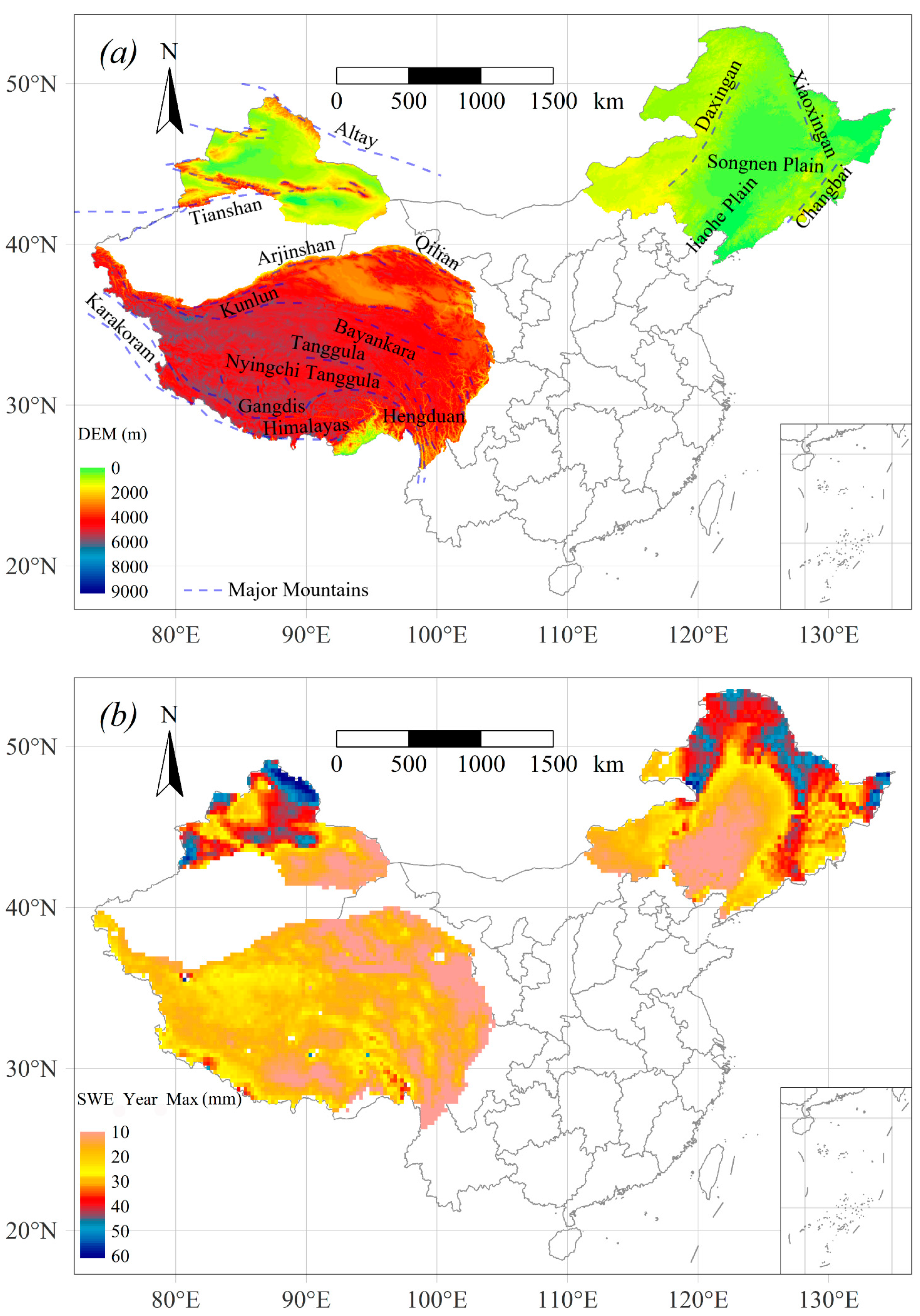

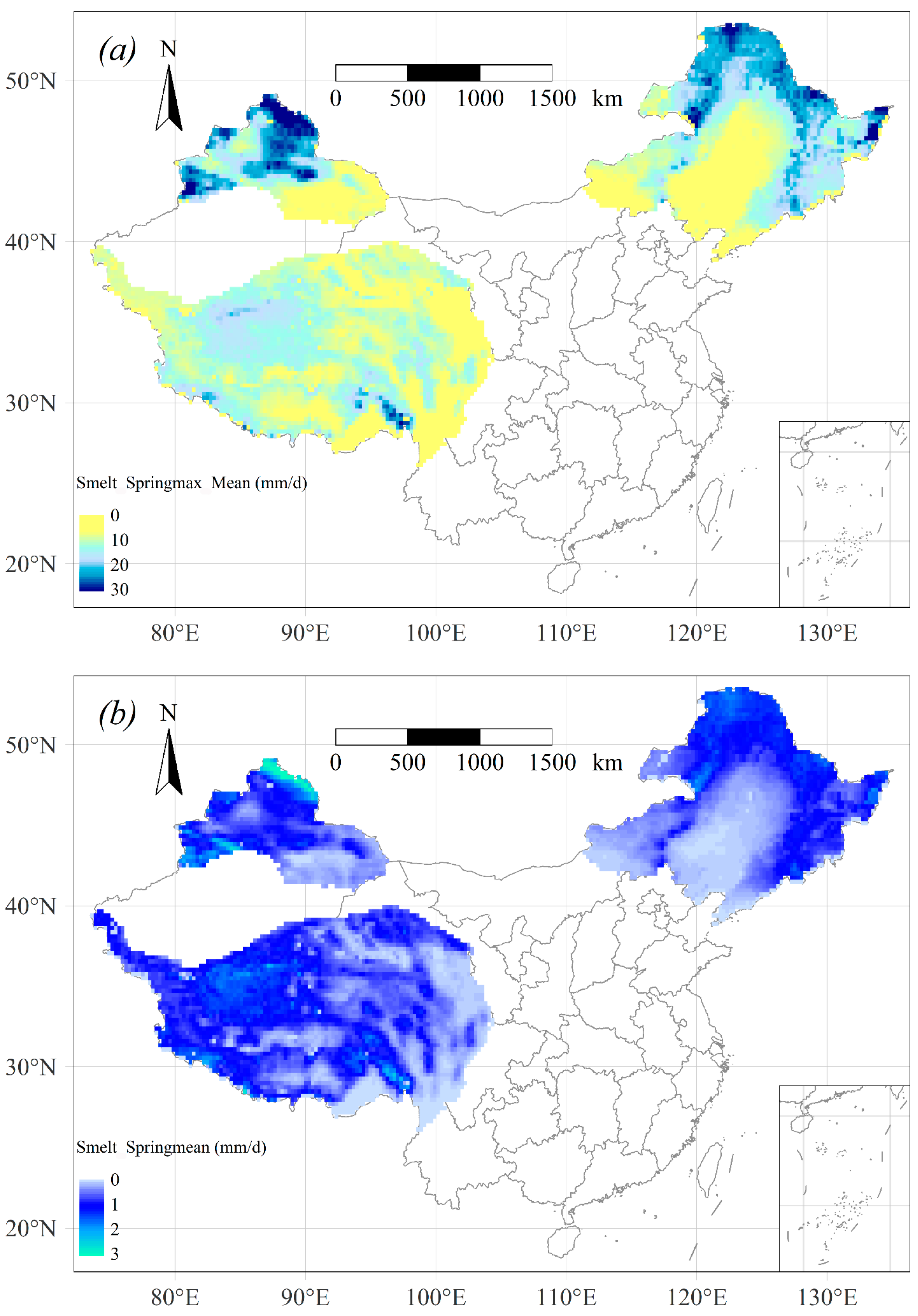
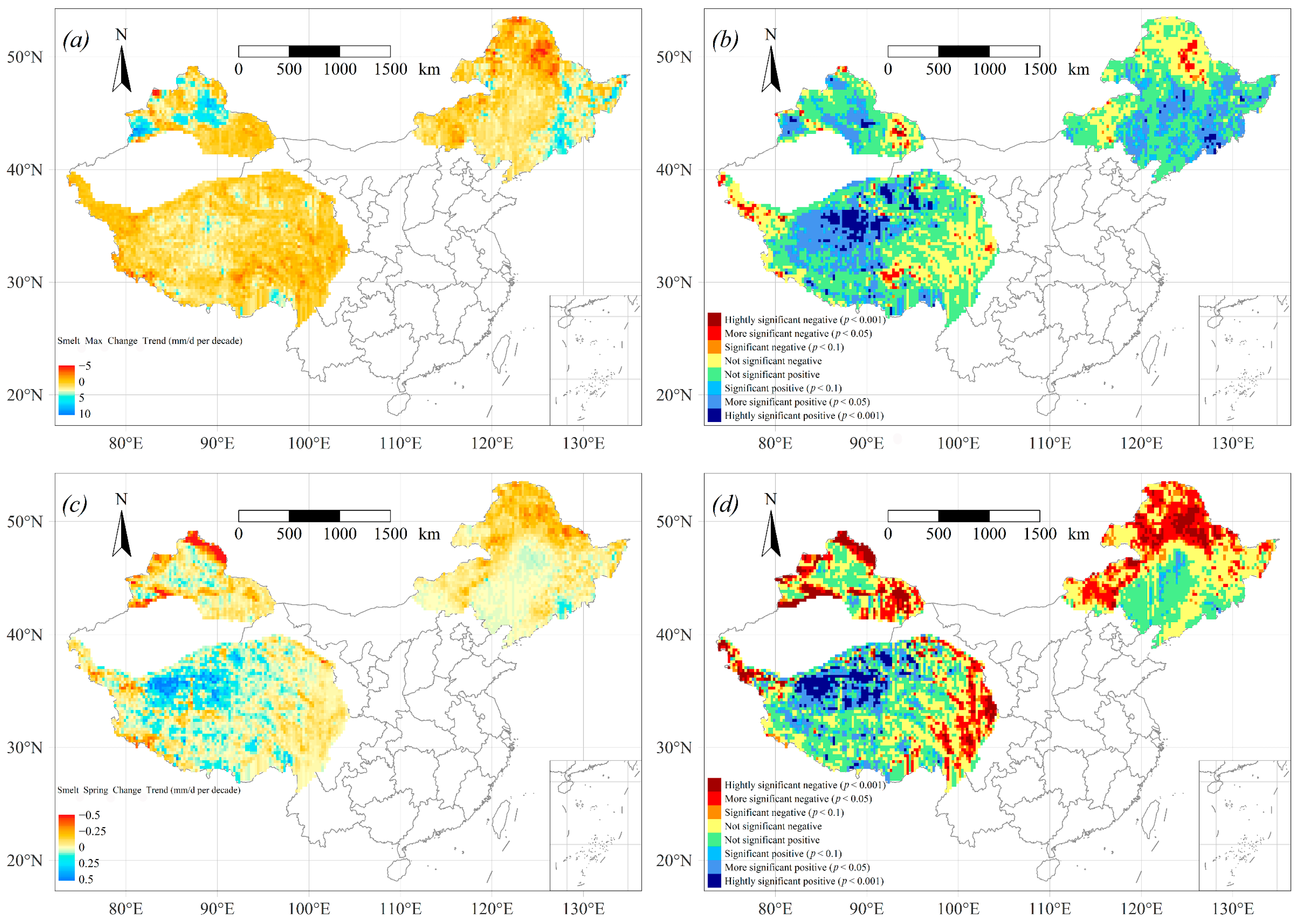
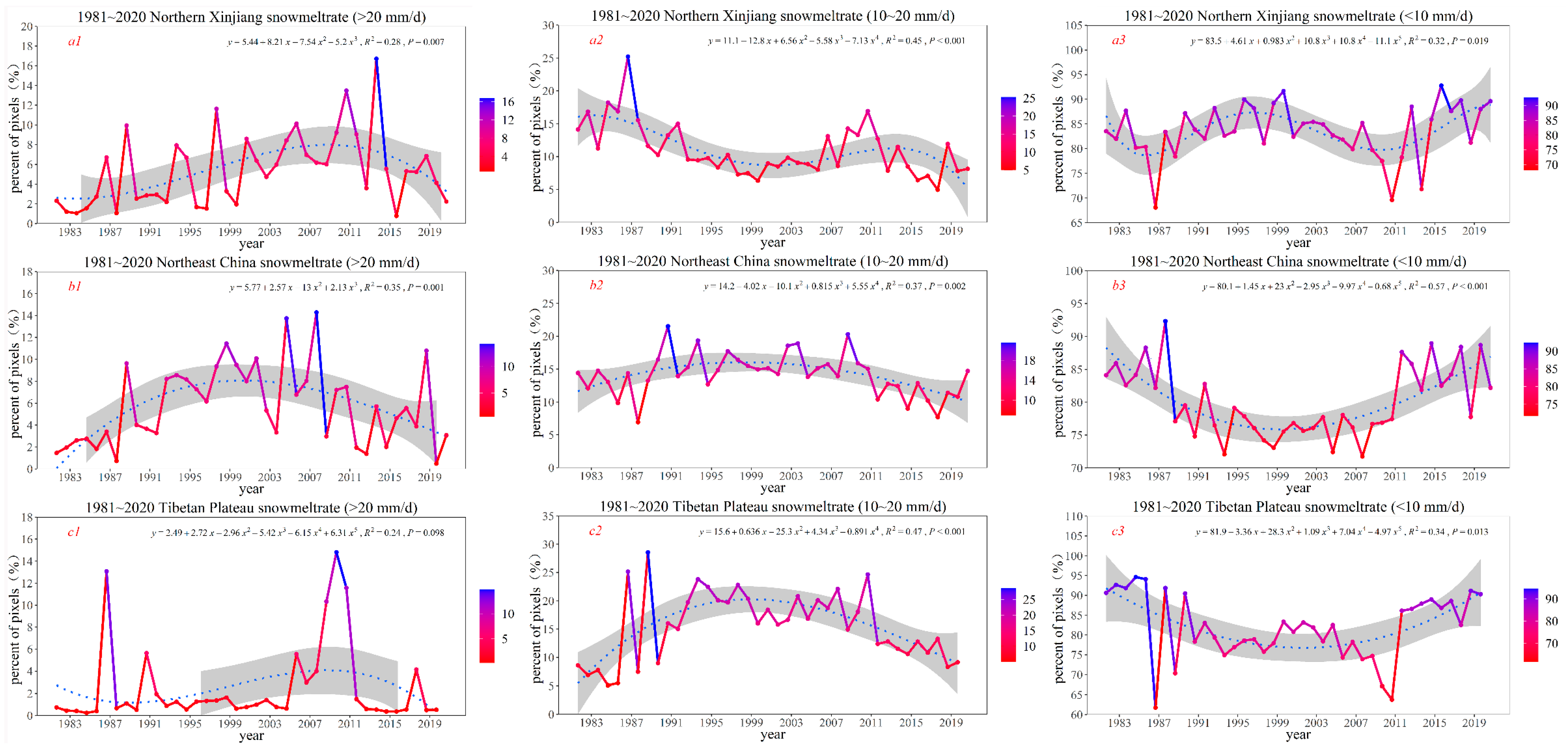
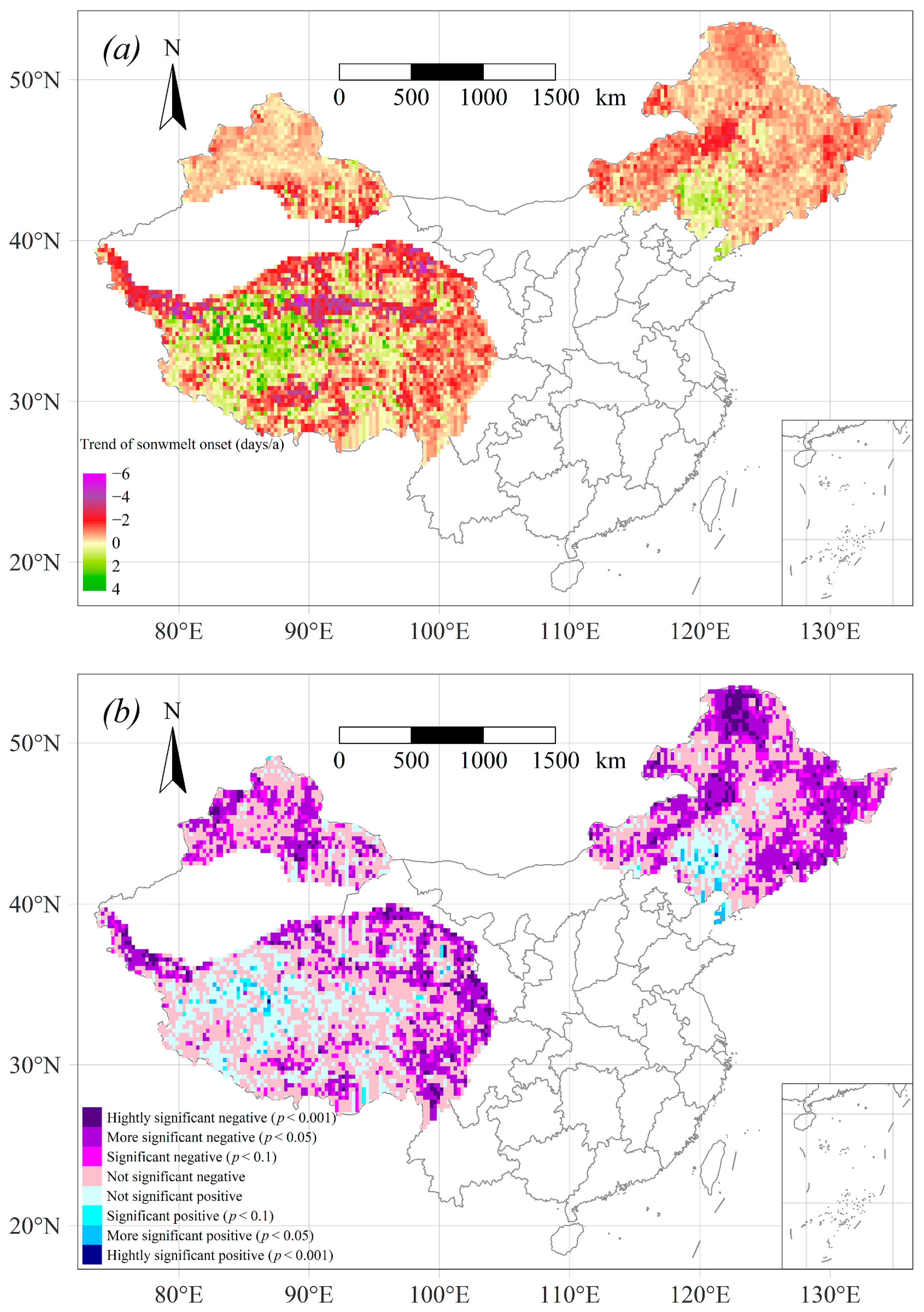
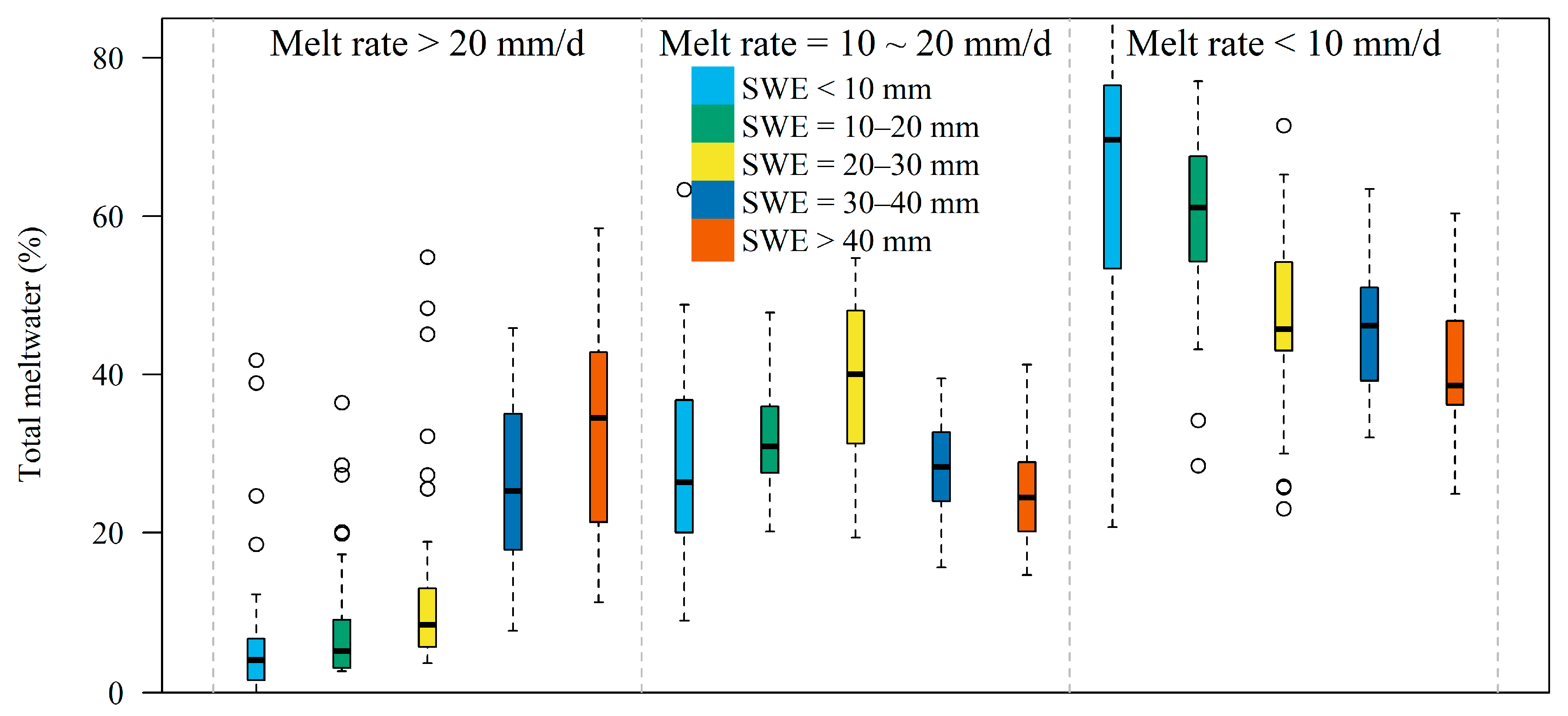
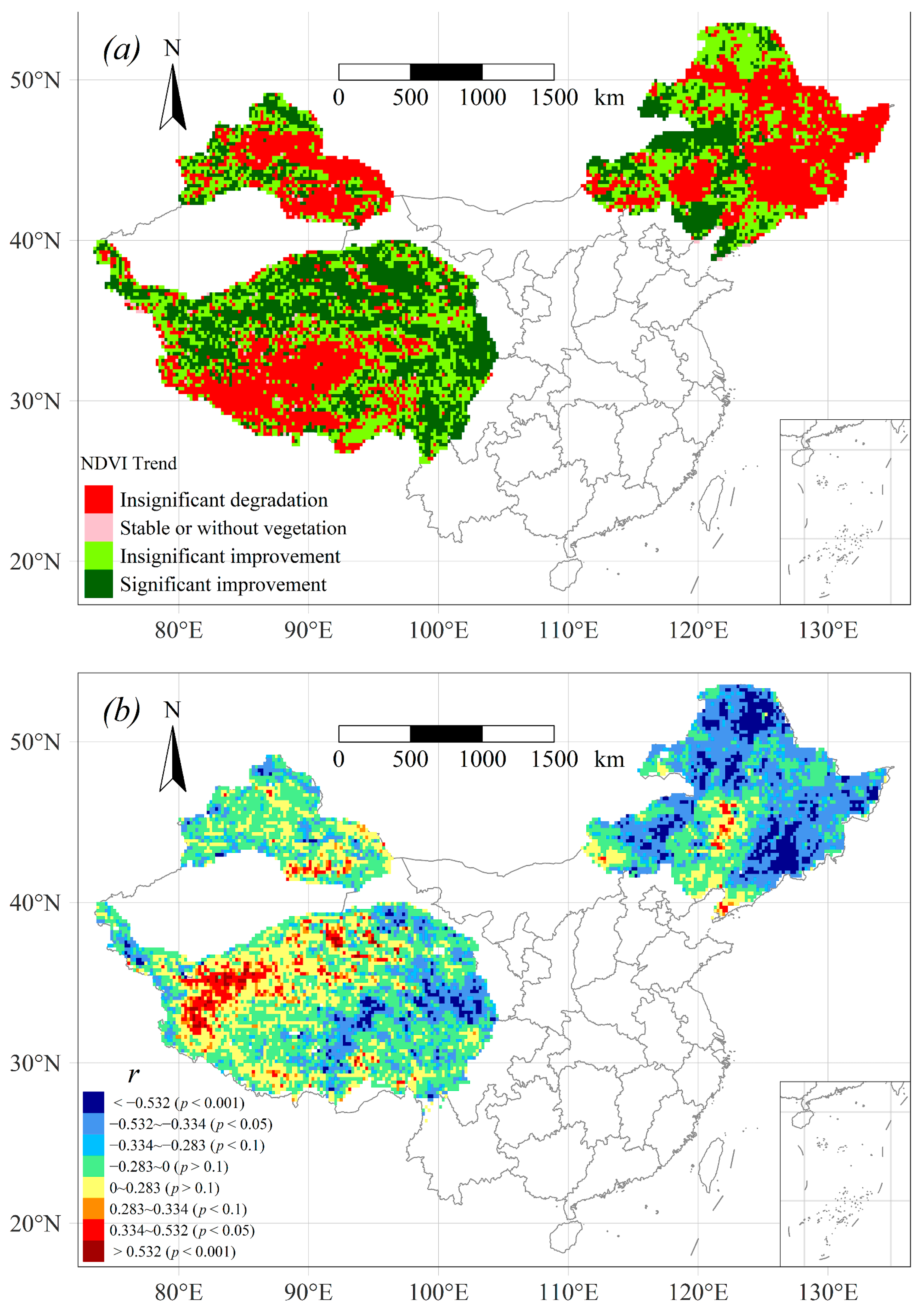
Publisher’s Note: MDPI stays neutral with regard to jurisdictional claims in published maps and institutional affiliations. |
© 2022 by the authors. Licensee MDPI, Basel, Switzerland. This article is an open access article distributed under the terms and conditions of the Creative Commons Attribution (CC BY) license (https://creativecommons.org/licenses/by/4.0/).
Share and Cite
Wu, X.; Zhu, R.; Long, Y.; Zhang, W. Spatial Trend and Impact of Snowmelt Rate in Spring across China’s Three Main Stable Snow Cover Regions over the Past 40 Years Based on Remote Sensing. Remote Sens. 2022, 14, 4176. https://doi.org/10.3390/rs14174176
Wu X, Zhu R, Long Y, Zhang W. Spatial Trend and Impact of Snowmelt Rate in Spring across China’s Three Main Stable Snow Cover Regions over the Past 40 Years Based on Remote Sensing. Remote Sensing. 2022; 14(17):4176. https://doi.org/10.3390/rs14174176
Chicago/Turabian StyleWu, Xuejiao, Rao Zhu, Yinping Long, and Wei Zhang. 2022. "Spatial Trend and Impact of Snowmelt Rate in Spring across China’s Three Main Stable Snow Cover Regions over the Past 40 Years Based on Remote Sensing" Remote Sensing 14, no. 17: 4176. https://doi.org/10.3390/rs14174176
APA StyleWu, X., Zhu, R., Long, Y., & Zhang, W. (2022). Spatial Trend and Impact of Snowmelt Rate in Spring across China’s Three Main Stable Snow Cover Regions over the Past 40 Years Based on Remote Sensing. Remote Sensing, 14(17), 4176. https://doi.org/10.3390/rs14174176





